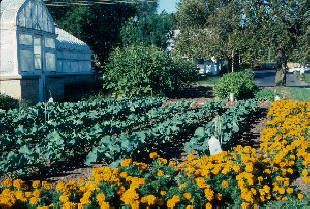Patty McDermitt
Adams County Master Gardener
 Companion planting is based on the idea that certain plants benefit when other plants are in close proximity. Some plants repel certain pests, others invite pests, and some are good for the soil, while others have higher yields when planted near their "companions".
Companion planting is based on the idea that certain plants benefit when other plants are in close proximity. Some plants repel certain pests, others invite pests, and some are good for the soil, while others have higher yields when planted near their "companions".
As I have learned, companion planting is easy and very beneficial to our success in the garden. As I planned my vegetable garden, I selected plants and their location to maximize my space. In doing so, I accidentally made decisions that were good for my garden and I was able to reap the benefits. I
did not have one unwanted pest in my garden this year and boy did it produce some delicious vegetables.
Companion planting is not a new concept. There is some evidence of ancient Roman farmers using companion planting. In North America, Native American Indians used the "Three Sisters Concept". For example, the Iroquois Indians planted corn, squash and beans together. The benefits are high-yield,
high-quality crops with minimal impact on the environment. Corn offers the structure for the beans to climb on, beans help to replenish the soil with nutrients and the large leaves of squash vines provide mulch that conserves water and reduces weeds. Native American tribes made enormous contributions to the food that we
still eat today and played a key role in the survival of all people in North American.
Here are some companion techniques to use in your garden:
 Mix up Monocrops - Growing a lot of one crop - use smaller plots and include one other vegetable. Example: Plant tomatoes and include scented marigolds or onions
Mix up Monocrops - Growing a lot of one crop - use smaller plots and include one other vegetable. Example: Plant tomatoes and include scented marigolds or onions
Interplant Herbs and Flowers - Plant flowers and herbs among your vegetables. By doing so you can attract beneficial insects and birds which will act as natural predators to the pests you don't want. Herbs can also confuse pests so they leave your crop alone. Example: Plant garlic among your roses.
Provide Refuge for Beneficial Bugs - Create habitats for creatures that prey on the pests. Examples of beneficials: are toads, lizards, snakes, birds and various insects.
Know Your Weeds - Work to identify weeds and wildflowers that appear in your garden so you know which ones will attract native beneficial organisms.
Benefits of companion planting include:
- Hide or mask crops from pests
- Produce odors that deter pests
- Provide trap crops which draw pests away for other plants
- Provide nurse plants that act as a breeding ground for beneficial insects
- Provide food to sustain good bugs
- Create habitat for favorable creatures
- Use fewer insecticides and herbicides.
As in life, there are plants that should not be companions. Here are a couple of examples of plants NOT to place near each other in the garden.
- Carrots and dill
- Tomatoes and anything from the cabbage family
- Bush beans and onions
- Cabbage family and strawberries
- Corn and tomato
There are many resources to help you select your garden vegetables and give you examples of garden layouts to use. One example is "Carrots Love Tomatoes" by Louise Riotte. Another one is "Great Garden Companions: A Companion-Planting System for a Beautiful, Chemical-Free Vegetable Garden" by Sally
Jean Cunningham.
Once you use this technique in your garden, it may be pest-free for years to come. …..And don't we have enough pests in our lives anyway?
Read other articles on ecological gardening & native plants